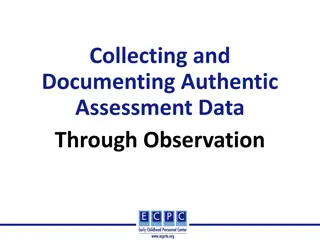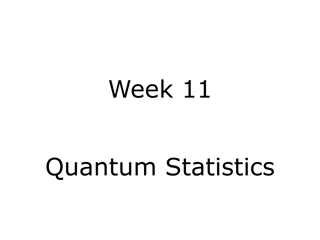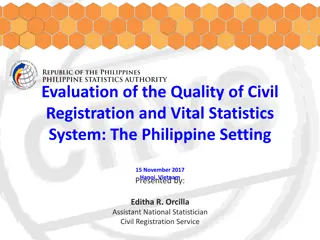E-portfolios in Statistics Assessment: Best Practices and Examples
Delve into the design and utilization of e-portfolios in statistics education. Explore validity, reliability, and fairness concepts, along with practical examples for job and graduate program applications. Learn about audience satisfaction, e-portfolio best practices for instructors and students, and critics' perspectives on assessment principles.
Uploaded on Feb 15, 2025 | 2 Views
Download Presentation

Please find below an Image/Link to download the presentation.
The content on the website is provided AS IS for your information and personal use only. It may not be sold, licensed, or shared on other websites without obtaining consent from the author.If you encounter any issues during the download, it is possible that the publisher has removed the file from their server.
You are allowed to download the files provided on this website for personal or commercial use, subject to the condition that they are used lawfully. All files are the property of their respective owners.
The content on the website is provided AS IS for your information and personal use only. It may not be sold, licensed, or shared on other websites without obtaining consent from the author.
E N D
Presentation Transcript
Greater CAC Density is Protective for C VD Events. The Multi-Ethnic Study of Atherosclerosis (MESA) Michael H. Criqui, MD, MPH MESA Steering Committee Meeting April 25, 2013
Co-authors J.O. Denenberg J. H. Ix R. L. McClelland C. L. Wassel D. E. Rifkin J. J. Carr M. J. Budoff M. A. Allison And thanks to all the MESA investigators, staff, and participants who have made the MESA possible
CAC of differing densities, with 4 phantoms of differing calcium densities Carr et al. Radiology 2005;234:35-43
Heart Scans from 3 Individuals Classified at Same CHD Risk According to FRS Mild calcification and early plaque build-up. Extensive calcification and plaque build-up. Normal coronaries with little or no plaque build-up.
Calculation of CAC Scores The Agatston score is the product of the within slice CAC plaque area and a plaque specific density factor of 1 (130-199 HU), 2 (200-299 HU), 3 (300-399 HU), or 4 ( 400HU), summed for all cardiac CT slices (i.e., upweighted for density) The volume score is the CAC area times the slice thickness, 3.0 mm for EBCT and 2.5 mm for multidetector scanners The area score is the Agaston score without the density weights. The MESA database does not have the individual area scores, so they were calculated by dividing the volume scores by the slice thickness The density score was defined as the Agatston score divided by the area score, and by definition ranged from 1 to 4
Methods 6814 men and women free of clinical CVD at baseline. Four ethnic groups: Non-Hispanic White, African-American, Hispanic, and Chinese General Framingham Risk Score (GFRS) calculated from age, HDL-C, total cholesterol, systolic blood pressure stratified by treatment, cigarette smoking, and diabetes Determination of coronary artery calcium (CAC) by computed tomography (CT) at baseline, with brightness adjustment by a phantom Calcification identified as a plaque 1 mm2 with a density 130 Hounsfield units, and quantitated by Agatston, volume, area, and density scores 1964 men and 1434 women had non-zero CAC scores (required for a density score) , GFRS data, and follow-up data for events
CVD Risk Factors, CAC measurements, and CVD Outcomes in Men and Women in MESA with Non-zero CAC Scores
Spearman Correlation Coefficients for Four CAC scores (all p-values < 0.0001) Ln (Agatston) Ln (Volume) Ln (Area) Density Ln (Agatston) 1.000 0.995 0.994 0.623 Ln (Volume) 1.000 0.998 0.560 Ln (Area) 1.00 0.539 Density 1.000 Note that the Agatston, volume, and area scores are extremely highly correlated, and thus should produce similar, although not identical, risk estimates. The density score shows a moderately high correlation with the other 3 scores
Hazard Ratios for Four Separate CAC Scores for Hard CHD and Hard CVD, Adjusted for Age, Sex, and Ethnicity, and Adjusted for the GFRS and Ethnicity
Multivariable Hazard Ratios for the Ln (Volume Score), Density Score, the GFRS, and Ethnicity for Hard CHD and Hard CVD
Hazard Ratios for Volume and Density Score Quartiles for Hard CHD, Adjusted for Each Other, Ethnicity, and the GFRS
Hazard Ratios for Volume and Density Score Quartiles for Hard CVD, Adjusted for Each Other, Ethnicity, and the GFRS
Changes in the Area Under the Receiver Operating Characteristic Curve (AUC) from Adding the Volume Score and Density Score to the Base Model* CHD CVD AUC P- value AUC P-value Base model* 0.664 ---- 0.666 ---- + volume score 0.699 0.004 0.687 0.015 +density score 0.709 0.062 0.699 0.023 * GFRS + ethnicity Note that the increase in the AUC with the volume score, though highly significant, is somewhat less than earlier reports from the MESA. This is because much of the increased prediction with CAC comes from the distinction between zero CAC and some CAC. This is also true for measures of reclassification.
Risk of incident CHD by coronary arteries affected and CAC score, CT angiography Hou et al. JACC Img 2012;5:990-9
Risk of incident CHD by coronary arteries affected and CAC score, CT angiography Hou et al. JACC Img 2012;5:990-9 183/1889 (10%) of plaque patients had CAC=0 (seen only by CT angio) with a high CHD risk, 22.7% 685/1889 (36%) of patients had mixed plaque with high CHD risk, 37.7% 1021/1889 (54%) of patients had all plaques calcified, and had a relatively low CHD risk, 5.5 %. The majority (60% - 1021/ 1706) of patients with CAC>0 were in this group. CAC density appears protective.
Conclusions At any given level of CAC volume, greater density of the CAC plaque was independently protective for CVD events, and the association was graded Including the density score in the multivariable model increased the effect size for the volume score These observations are consistent with current vulnerable plaque theory The standard CAC score, the Agatston, which is upweighted for increased CAC density, is flawed Use of CAC measures in predicting CVD events should include consideration of density
Is the Agatston score the best we can do? No Despite the strong predictive power of the Agatston score, there appears to be considerable additional information in CT scans that can be used to maximize the predictive value of CAC Acquiring this information will require new CT data interrogation techniques increased CAC density appears to be protective for CHD/CVD
Are there scoring issues beyond density? The number of arteries may be independently predictive of CVD (Blaha et al. MESA, AHA Scien Sess, LA, CA 11/12). Specific coronary arteries may be independently predictive; e.g., the left main (Williams et al, JACC Img 2008, Hou et al JACC Imag 2012), but Blaha et al MESA analysis says no. CAC spatial distribution may add to predictive value (Brown et al. Coronary calcium coverage score (MESA) Radiology 2008. Shemesh et al. Ordinal score. Radiology 2010) Dedicated, gated cardiac CT scans may not be necessary to measure CAC. CAC software may work equally well on standard chest CTs (Wu et al. Am J Roentgenol 2008) Simpler scoring systems on standard CTs may be equally predictive, such as the ordinal score (Shemesh et al. Ordinal score. Radiology 2010)
So what should we do next? CAC volume, CAC density, CAC spatial distribution, the number of and specific coronary arteries affected are correlated variables, and require careful multivariable analysis to determine independence, and the possibility of effect-modification An optimal CAC scoring system or systems should be developed in MESA and validated on a second cohort We have proposed to do just that, and the validation cohort is the LifeScore Study in San Diego, N= 4,544 persons with whole body scans
Pending grant proposal - Coronary Calcium Score Method and Cardiovascular Disease Events in Two Cohorts The specific aims of this proposal address exploring each of the scoring issues noted Proposal reviewed February, 2013 Score = 9th percentile Funding = ???? Anybody know anybody at the NHLBI?























